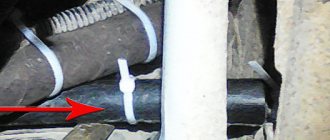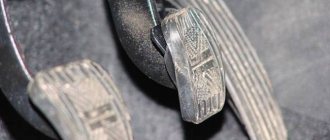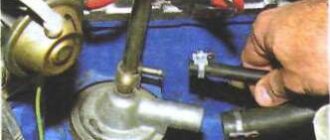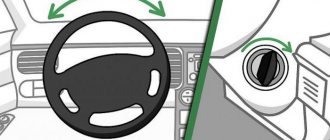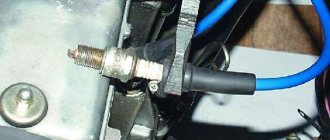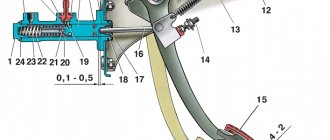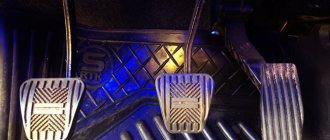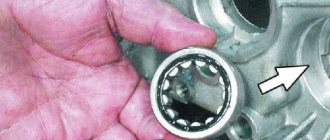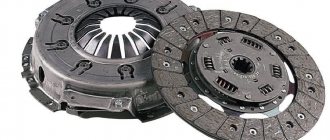Good day, dear motorists! The life of a motorist is connected with constant stress, that’s a fact. In addition to the dynamics of road traffic, which, in principle, does not allow the driver to relax, there are also unpleasant situations with the unexpected failure of the car. Precisely while moving, in traffic, or precisely far from home.
Such troubles include traditional ones: the brakes have failed and the clutch has disappeared. The most common question on the forums of car drivers of almost all brands and models is this: the clutch pedal has failed, help... help.
Of course, there are many reasons for a clutch to fail. We will try to consider several reasons that contribute to the fact that the clutch pedal does not return.
Why did the clutch pedal fail?
Here we will look at the causes and methods for eliminating them in stationary conditions. Either at a service station, or repairing the clutch yourself in the garage. Operations such as replacing or repairing the main clutch or control valve are completely doable in a garage, if you have a repair kit for the clutch master or slave cylinder.
So, why does the clutch pedal not return (the clutch pedal “fails”)?
- The clutch cable broke in the place where its tip is sealed. You are unlikely to fix this malfunction on the spot, although some people recommend carrying a spare cable with you? so that the faulty cable can be replaced. But, it’s problematic to carry every spare part and component with you;
- The return spring has either fallen off or burst. If the spring falls off, it returns to its place. If a spring breaks, then, as in the case of a cable, either in a “tug” or under its own power to a service station or to a garage. How to drive without a clutch? More on this below;
- Air has entered the hydraulic drive system. In this case, only bleeding the clutch to remove air can help;
- The clutch fork is broken. And in this case, the answer is clear - the clutch fork needs to be replaced;
- the clutch pedal has failed, but it is possible to engage the clutch briefly only by very sharply pressing the pedal, the fault is with the clutch master cylinder: defects in the mirror, defect or wear of the main clutch cuff. The problem is solved by replacing the clutch master cylinder.
Clutch lost, how to get to the service station
Yet it happened - the clutch pedal fell through and did not return. Even with the help of a leg, it still doesn’t come back. It’s daytime, heavy traffic, and our task is to get to a car service center, to a garage, or at least to the nearest parking lot.
Signs of a slipping clutch
The fact that the clutch on a VAZ 2114 is slipping can be understood by the smell of burnt rubber caused by burning ferodo. In this case, excessive fuel consumption will be observed, and the engine will overheat with poor traction. A car with a slipping clutch does not pick up speed well, even if you press the clutch pedal to the floor. The car is especially hard going uphill. It looks like it's running out of gas.
Useful : Rating of the best clutches for VAZ 2114 (TOP 9 manufacturers)
To understand how to troubleshoot problems, you need to know the causes of clutch slipping.
- the driven disc lining wears out or becomes mechanically damaged;
- the driven disk becomes oily;
- the diaphragm spring breaks or weakens.
- The surface of the flywheel is erased:
- the hydraulic drive becomes clogged;
- the clutch release cable or fork is stuck;
- The working cylinder fails.
Driving without a clutch: what you need to know
Taking into account the fact that most breakdowns that are associated with the clutch or clutch pedal (for example, the clutch pedal has failed) can take the driver by surprise, and it is often impossible to fix problems on the spot, the only option is to drive to the service station under your own power.
At the same time, we draw your attention once again to the fact that the methods described below should be used only in cases of extreme necessity, since the risk of damaging the box or getting into an accident increases significantly.
- So, first you need to turn off the car engine. If you lose traction on a hill, you should push the car onto a level road. Then it is recommended to think over the route in advance so that, if possible, you travel along a route with a minimum number of traffic lights, pedestrian crossings, not congested with traffic, so that you do not have to stop often, etc.;
- Next, with the engine turned off, you should engage first gear, and you also need to turn on the emergency lights, after which the engine can be started (note that the car will jerk forward sharply immediately after turning the key in the ignition switch to the “start” position);
Let us also add that beginners in such a situation should be prepared for the fact that the engine will stall when it comes to a complete stop or greatly reduces the speed without turning off first gear. This means that in this case you will have to start again on the first one.
This is possible if the driver feels when engaging a gear without a clutch with minimal effort can, without much risk, seriously damage the gearbox and transmission parts, taking into account engine speed and speed. However, if you try to do this without experience and skills, there is a high risk of damaging the gearbox, significantly reducing the life of the unit, or completely destroying the gearbox and other transmission elements.
Self-diagnosis of the clutch on a VAZ 2114
You can understand that the clutch assemblies have worn out and need preventive inspection, and possibly repair, by the following four signs:
- If you have a manual transmission, and the clutch “grabs” when the pedal is still in the upper position. And the earlier the setting occurs, the worse the condition of the node turns out to be.
- The speed characteristics of the car have decreased. The clutch discs slip and this causes loss of power. The torque is not completely transmitted from the internal combustion engine to the gearbox and wheels. The first sign of a problem is a drop in dynamics when trying to tow a trailer.
- The car starts moving abruptly and jerkily. The reason lies in the destruction of the ferodo surface. Warping of the disc occurs due to its overheating, which is caused by increased force on the clutch part.
- It is difficult to switch some gears at the gearbox. When switching from one speed to another, an unpleasant grinding noise appears. If repairs are not started in a timely manner, soon all speeds will stop switching. This occurs because the driven and driving discs do not move completely apart when the pedal is depressed, and the clutch “drives.”
Some proven methods will help make sure that all of the above signs really indicate a problem with the clutch. To do this, it is advisable to choose a flat and, if possible, deserted section of the road. In 4th gear, accelerate the car to 65 km per hour and take your foot off the gas pedal. The car will slowly slow down. When the speed reaches 40 km per hour, or becomes “choking”, increase the gas. At the same time, carefully monitor the speedometer and tachometer readings. When the clutch is working normally, the arrows of both instruments will begin to move evenly to the right. If the engine gains power, but the speed does not increase, it is obvious that the clutch discs are worn out. And even if the discs are worn out, a characteristic whistle may appear on the motor side. If several signs of a failed clutch appear, you need to go to a car repair shop for diagnostics, which is performed using special equipment.
The photo shows a “dead” clutch
How to get to the nearest service station or home if the clutch pedal has failed?
The task, although not easy, is still quite realistic. The main thing here is to get going and not take your foot off the gas, maintaining the speed in first gear.
You need to proceed as follows
We warm up the engine, turn on the emergency lights, then turn on first gear, and turn the key in the ignition. When the engine starts to “catch”, give the gas and start moving. With the right approach, the car will not stall, and you will be able to move away and slowly get to your destination. Don't try to change gear without a clutch - it is certainly possible, there is a technique, but without the proper skill you will most likely stall or damage your transmission.
Now you know why the clutch pedal does not return, for what reasons this happens and how to solve this problem. In addition, if this happens, you will know how to get home if the VAZ clutch pedal fails. That's all for me, write in the comments how you solved this problem and what signs of malfunction you had and the cause of the breakdown. Thank you all for your attention and see you again at VAZ Repair. Bye.
What to do if the clutch slips?
If the clutch mechanism has been working for a long time and is very old, you are convinced that it is time to change it, then buy a new set of discs and other spare parts and get ready to completely replace it. During normal, proper operation of the vehicle, clutch discs are designed to last 100 thousand km. mileage
If you installed the clutch relatively recently, and it slips or “leads,” then you can try to fight for it. Perhaps adjusting the cable sheath, discs, diaphragm spring and other clutch elements will help solve the problem. Let's remember what malfunctions and defects occur in the clutch. The free play of the pedal has increased, and the clutch engages in the upper pedal position. This happens for two reasons: during operation, the cable is pulled out, and the discs are gradually worn out. Due to this, the distance between the pedal and the clutch release fork changes. In this case, you can adjust the cable sheath. Its length is adjusted using adjusting nuts (3). Normally, the clutch pedal travel is 12.5-13.5 cm. If it turns out to be less or more, adjustment must be made.
The picture shows the clutch cable sheath with adjusting nuts
Driven disk (ferodo)
The most common malfunction is wear and damage to the driven disk linings. Rubber pads are the most vulnerable link in the clutch. They are made of rubber or composite heat-resistant material and are built into the metal of the disk. When chips or cracks form on them, they cannot be replaced separately from the disk. When the linings wear out or change their original shape, the entire driven mechanism has to be changed. The passive drive must also be replaced in the following cases:
- If the disk itself is deformed;
- Damper springs broke due to overheating;
- The splines in the hub have worn out.
When oiling the friction linings with ferodo, it is enough to wash them with kerosene, lightly sand them with zero to create roughness, and they will still work.
Clutch basket
The clutch basket presses the passive disc against the flywheel. It consists of a pressure plate, a diaphragm spring and a casing. The clutch can also slip when the elements of the basket are faulty. The symptoms of failure of the basket are the same as when the driven disk fails. So, if inspection of the ferodo does not reveal obvious defects, you should pay attention to the next block of parts. It is when there is a problem with the baskets that the gears stop shifting. But to make sure that it is the basket that is to blame for clutch problems, you will have to dismantle and diagnose this unit. Basket malfunctions include weakening or breakage of the diaphragm spring, breakage of the release bearing (13). The diaphragm spring wears out faster and more often. Due to constant temperature changes, its petals lose their springy properties and become fragile. With frequent overheating, blue burn spots appear on the petals. And since the cause of overheating is poor operation of the mechanism release clutch (13), it should also be diagnosed. The petals themselves are deformed and do not lie in one plane. The appearance of cracks and mechanical damage on the spring indicates the need to replace it. The basket must be completely replaced even if the curvature of the pressure plate exceeds 0.8 mm. The disc is placed on its edge, and the curvature is measured with a ruler.
Flywheel
This unit also wears out during operation of the VAZ 2114. The following signs indicate flywheel wear:
- Strong vibration in the floor when you depress the clutch pedal,
Burnt smell;
- Inability of the gearbox to shift to the next gear, i.e. gear slipping.
- Sometimes you hear grinding gears when changing gears.
Inspection and diagnostics of the angles will show why the clutch on the VAZ 2114 is slipping, whether a complete replacement of all parts of the clutch system is necessary, or whether you can limit yourself to adjusting and replacing individual elements. Let us remind you that if the clutch has exhausted its service life, it is useless to patch it; it is better to change the entire system.
Please note that if the disc wear is 40-50%, such wear is not critical, and if there is no external damage, then the discs will still serve
Methods for solving the problem
If the clutch pedal fails while driving a car, then there are not many ways to solve the problem. We recommend that you familiarize yourself with all the methods so that in the event of a corresponding breakdown you know how to behave.
Replacing the cable
To replace the cable, you will need the cable itself, as well as wrenches and pliers. It is advisable to use a spanner or open-end wrench, this will be much more convenient.
But if you don’t have a box and open-end wrench on hand, you can also use a regular wrench:
- Open the hood of your car. In the engine compartment you need to find the very place where the cable is attached to the tip. Since a break occurred, most likely the tip remained in the installation location, and the cable itself was dangling. You need to remove the tip using a wrench.
- Then get inside the car and disconnect the cable directly from the clutch pedal. Remove the cable.
- Take the new cable and install it in place of the old one, the entire assembly occurs in the reverse order.
- You need to measure the free code of the pedal, and then adjust the installed element. The free play should be no more than 3 cm, and the total should be no more than 14.7 cm. The accelerator travel is adjusted using the nuts on the end of the cable in the engine compartment.
1. Unscrew the fastening nuts
2. Remove the locking bracket
3. Adjust the new cable
If the spring breaks
If the return spring bursts, the procedure will be different. To replace, you will need the spring itself; if you do not carry it with you, you will have to go to the nearest spare parts store.
How to change a spring:
- Open the hood and use a wrench (it’s more convenient to use a spanner) to unscrew the cable nut. You need to extract it.
- Carefully, so that the remains of the old return spring do not fall apart, remove them. Please follow all safety rules.
- Take the new part and install it in place of the old one. This also needs to be done carefully, since in this case it is very easy to damage your hand or fingers.
- Then reinstall the cable. Tighten the nut. After this, adjust the free and overall travel of the pedal. Start the engine and try to drive it.
1. Unscrew the fastening nut.
2. Remove the spring and replace it with a new one
How to get to the service station on your own?
Of course, it will be better for the driver if this breakdown occurs near his home, then you can consider yourself lucky. But if this happened on the road, and the nearest service station is not so close that you could push the car to it, then this is already a problem. But there is a way out of every situation, so if the clutch pedal fails, you can still get to the nearest service station, and now we’ll tell you how.
To drive in first gear - if you need to restore the pedal's functionality, you can do the following:
- The gearshift lever must be moved from neutral to first gear. In this case, the gas must be released.
- Start turning the key in the ignition. When the engine tries to start, apply gas, but do it so that the car does not stall.
- When the car starts to move, do not try to change to the next gear. This is fraught with breakdown of the gearbox, and its repair, believe me, will cost more than calling a tow truck.
In general, the same method allows you to start moving at second speed.
But before you do this, check out some important points:
- When the pedal fails, do your best to stop the car on a downhill slope or on a straight road without the car rolling backwards.
- Warm up the engine before driving.
- Before you start moving, carefully consider your entire route, because you need to take into account all the nuances. This includes the number of intersections, traffic lights, where you should turn from and where, and so on. It will be more convenient to drive only on the main road, so that you don’t have to stop to let other cars pass.
- Turn on the warning lights (hazard warning lights).
- Avoid unnecessary maneuvers and remember that no one knows about this problem except you. It’s better to stop once again and repeat the procedure than to create more serious problems for yourself.
- If you are not sure that you can cope with such a task on your own, then maybe it makes sense to call a tow truck or tow the car to a service station?
Loading …
When it is necessary?
Drivers often wonder when it is necessary to adjust the clutch. And how to determine the problem without visiting a service center. In fact, diagnosing this malfunction is very simple; experienced mechanics recommend checking it once every 2 months. First, we will look at the signs that clearly indicate the need for adjustment:
- The pedal fell to the floor. If the position of the pedal has moved down, then it needs to be adjusted;
- The clutch does not disengage completely. This can be felt through jolts and when trying to shift;
- While driving, you can smell the smell of a burning clutch. One of the reasons may be a failure of adjustments.
In any of these cases, it is necessary to make adjustments as quickly as possible.
Otherwise, you may end up having to replace the disc, or even the entire clutch. Examination
. Before making adjustments, you must check the position of the pedal. To do this, take a ruler and measure the distance from the floor to the pedal platform. The normal figure is 12-13 centimeters. A distance of up to 16 centimeters is considered acceptable. If the indicator is more or less, then the mechanism needs to be adjusted. By the way, the clutch is checked in the same way on all modifications of “eights” and “nines”. But, some indicators may differ, so check the data for your model.
